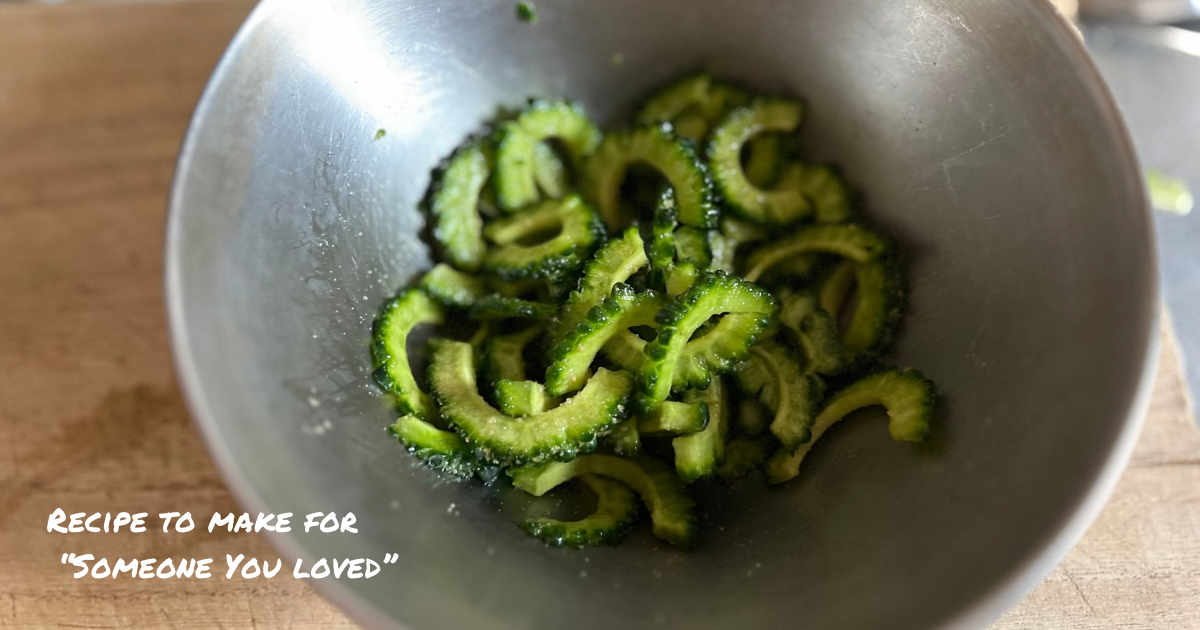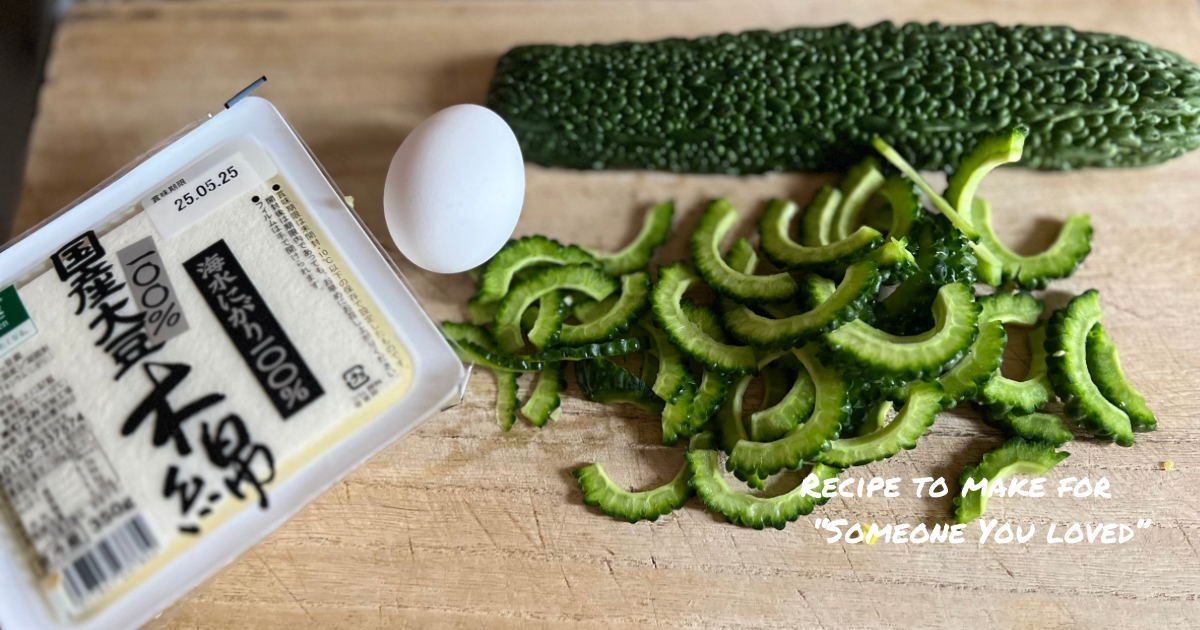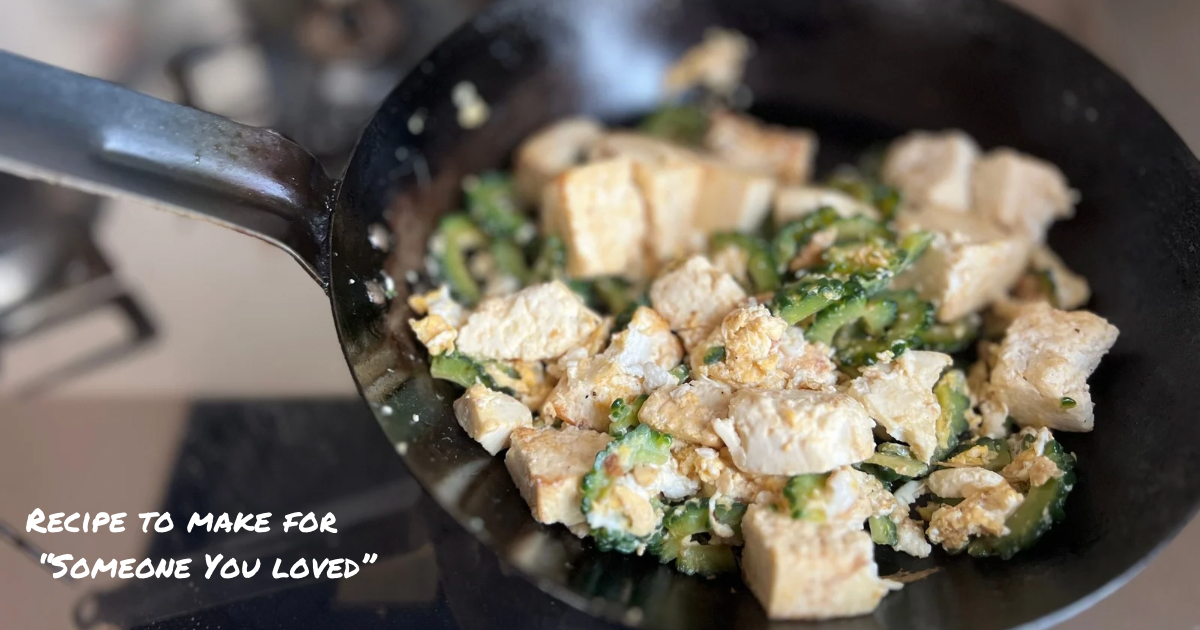
今日のテーマは「ゴーヤ」
これから夏にかけてスーパーに並びますね。旬は6月から8月頃。ゴーヤと聞いて思い浮かぶキーワードは何ですか?

苦い成分はゴーヤのワタや果肉の白い部分に特に多く含まれています。このゴーヤのワタ(白い部分)や種には毒性は無くて加熱すれば柔らかくなり、苦味も少なめで、ほんのり甘みを感じることもあるそう。
![]()
この苦味は胃腸を刺激して食欲をアップさせるので夏バテ予防になるとのこと。血糖値を下げる作用があるとも言われ、糖尿病予防への研究もあるようです

ゴーヤの中の辛味成分を含んだワタや果肉の水分を塩や砂糖で揉み込むことで取り除くことができます。塩もみすると水分が表面に出てきますよね?
これは浸透圧のちからによるもの。中身の白い果肉部分より、ゴツゴツした皮の方が水分が少ないから、水分が少ないほうに浸み出していく
![]()

塩もみしてとよく言われますが、砂糖も塩と同様に浸透圧のちからがあるので、砂糖で揉み込んでも効果はあります。
参考
■ ゴーヤ1本(約200g)に対しての目安
• 砂糖:大さじ1〜2
• 塩:ひとつまみ〜小さじ1/3
■使い方
1. ゴーヤを薄切りにする(5mmくらいがおすすめ)
2. 砂糖と塩をまぶして、よくもみこむ
3. 10〜15分おいて、水分が出たらしぼる
4. そのまま使う or 軽く水洗いしてしぼる
■ポイント
*苦味をしっかり抜きたい → 塩をやや多め
*ほんのり甘く仕上げたい → 砂糖をやや多めにお子さん向けやサラダに使うときは砂糖多めがおすすめです。(甘ったるくなりません)
*サラダなど生食する場合、塩や砂糖を使って水分を出した後さっと湯通し(30秒)するのも苦味 を取り除く方法の一つ
【用途別】ゴーヤの下ごしらえ分量とコツ
1. 炒め物(ゴーヤチャンプルーなど)
• ゴーヤ1本に対して:
• 塩:小さじ1/3
• 砂糖:大さじ1
コツ:しっかり炒めるので、多少苦味が残ってもOK
苦味を少し残した方が料理全体にメリハリが出る
砂糖は苦味をまろやかにし、味つけのベースにも
2. サラダ(生で使う、冷製)
• ゴーヤ1本に対して:
• 塩:小さじ1/2〜1
• 砂糖:大さじ1.5〜2
• コツ:生で使うので、苦味はしっかり抜くのが鉄則!よくもんで10〜15分置いたあと、水で洗ってしっかり絞る
3. おひたし・和え物(さっぱり系)
ゴーヤ1本に対して
塩:小さじ1/3
砂糖:大さじ1
コツ:湯がく工程があるので、下ごしらえは控えめでOK
塩気は控えめにしておくと、だしや醤油とケンカしない
ゴーヤを薄めに切ると食べやすい
ある日のゴーヤチャンプルレシピ
(豚肉を入れ忘れてしまいました)
ゴーヤ 半分
木綿豆腐 1パック
卵 1個
豚コマ肉、豚バラ肉でもOK (写真には映ってません)
和風顆粒だし 小さじ1
しょうゆ 小さじ1

豆腐はペーパーを巻いて水切りをして、大きめに切っておく
ゴーヤは半分に切ってワタとタネをスプーンで取り除き薄切りにして、上記を参考に砂糖と塩で下処理をしておく。
豚肉は食べやすいサイズに切る
熱したフライパンに油をいれて、豆腐の全面に焼き色を付けるように焼き一旦取り出す。
同じフライパンで豚肉とゴーヤを炒めたら、先ほど取り出した豆腐を加える。
和風顆粒だし 小さじ1、としょうゆ 小さじ1を入れたら溶き卵を流し込み大きくかき混ぜて完成。
(こちらの画像には豚肉が入ってません)

Translation
Today’s Ingredient: Goya (Bitter Melon)
As summer approaches, goya starts popping up more often in supermarkets. Its peak season runs from June to August. When you hear “goya,” what’s the first word that comes to mind?
Bitter.
That distinctive bitterness comes mostly from the white pith and flesh inside the goya. Interestingly, the pith and seeds aren’t toxic at all—in fact, when cooked, they soften and mellow out. Sometimes, they even develop a hint of sweetness.
Personally, I’m not a fan of the bitterness, so I usually scoop everything out!
But did you know that bitterness actually has health benefits? It stimulates digestion and boosts appetite—great for preventing summer fatigue. It’s also said to help lower blood sugar levels, and there’s ongoing research into its potential for diabetes prevention.
So how do you reduce the bitterness?
The key is drawing out the bitter juices using salt or sugar. Ever notice how salt makes water seep out of veggies? That’s thanks to osmosis. Since the skin of the goya is drier than the flesh, the moisture naturally moves outward when you massage it with salt or sugar.
Hard to explain in words—but trust me, it works.
And yes, sugar works just like salt here. Both draw out the moisture and the bitterness.
Quick Reference:
For 1 goya (about 200g):
- Sugar: 1–2 tablespoons
- Salt: A pinch to 1/3 teaspoon
How to Prep Goya:
- Slice goya thinly (about 5mm is ideal).
- Rub with sugar and salt.
- Let sit for 10–15 minutes until moisture appears.
- Squeeze out the water. You can use it as is or rinse lightly and squeeze again.
Tips:
- Want to remove most of the bitterness? Use a bit more salt.
- Prefer a slightly sweet touch (great for kids or salads)? Use more sugar. It won’t taste overly sweet.
- If eating raw in salads, a quick 30-second blanch after drawing out moisture helps tone down bitterness even more.
Goya Prep by Dish:
1. Stir-Fries (like Goya Champuru):
- Salt: 1/3 tsp
- Sugar: 1 tbsp
Tip: Some bitterness adds depth to stir-fries. Sugar helps balance the flavor.
2. Salads (raw or chilled):
- Salt: 1/2–1 tsp
- Sugar: 1.5–2 tbsp
Tip: Since it’s eaten raw, really work in the sugar/salt and let it sit. Rinse well afterward.
3. Light Side Dishes (like ohitashi or vinegared dishes):
- Salt: 1/3 tsp
- Sugar: 1 tbsp
Tip: Since you’ll blanch it, you don’t need intense prep. Go light on the salt so it won’t clash with the dashi or soy sauce.
One Day’s Goya Champuru (without Pork!):
I accidentally forgot the pork in this one—oops!
- Half a goya
- 1 pack firm tofu
- 1 egg
- Pork (pork belly or sliced shoulder is great—just not pictured)
- 1 tsp Japanese-style dashi powder
- 1 tsp soy sauce
How to Make It:
- Wrap tofu in paper towels to drain water. Cut into large pieces.
- Halve the goya, scoop out the pith and seeds, and slice thinly. Prep with sugar and salt as mentioned above.
- Cut pork into bite-size pieces.
Heat oil in a pan, sear the tofu on all sides until golden, then set aside. In the same pan, stir-fry the pork and goya. Add the tofu back in, season with dashi powder and soy sauce, pour in a beaten egg, stir gently, and you’re done!
(No pork in the photo, but you get the idea!)
